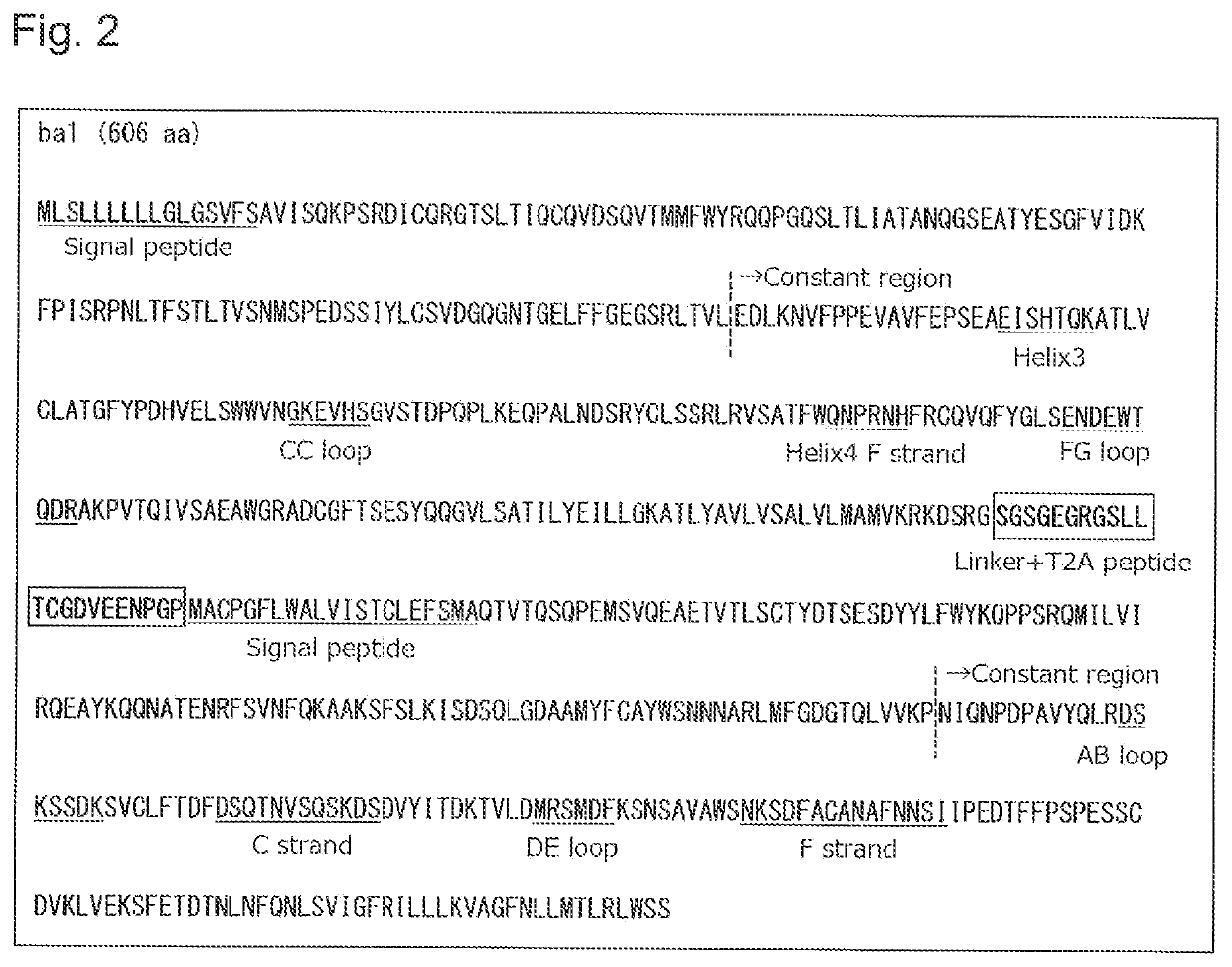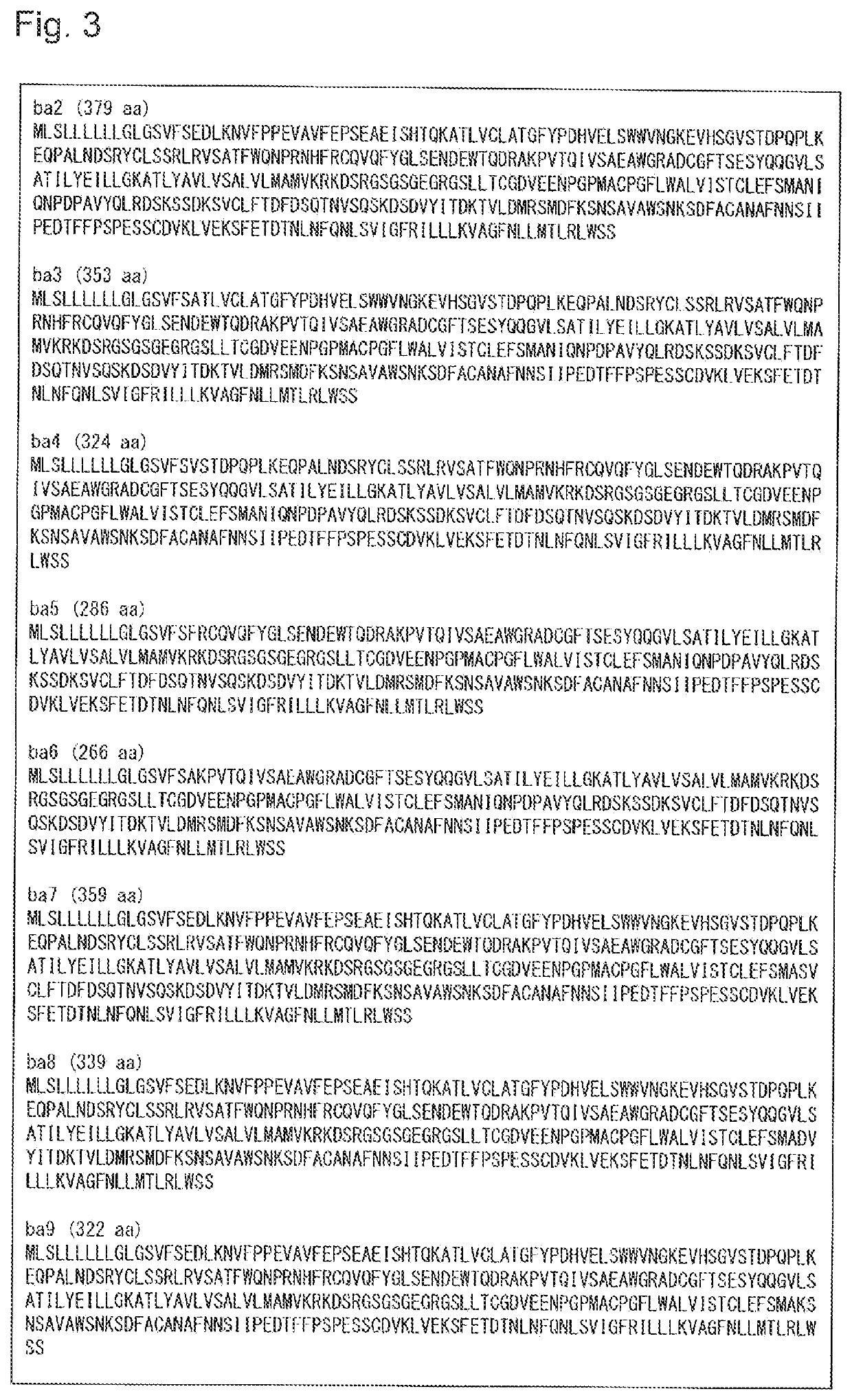Modified tcr and production method therefor
a technology of tcr and tcr, which is applied in the field of modified tcr, can solve the problems of tissue injury caused by potent alloreaction caused by various tcr/tcr heterodimers which non-autologous t cells, and achieve the effect of losing the ability to recognize antibodies
- Summary
- Abstract
- Description
- Claims
- Application Information
AI Technical Summary
Benefits of technology
Problems solved by technology
Method used
Image
Examples
example 1
[0269]The capabilities of holding CD3 subunit molecules of modified TCRs were analyzed in 293T cells.
[0270]First, a full-length TCR expression vector was constructed. As the full-length TCRα chain and full-length TCRβ chain genes, the TCR gene sequences derived from T cell-derived iPS cell line TKT3v1-7 established by introducing Yamanaka factors into T cell (provided by The University of Tokyo, described in Nishimura et al., Cell Stem Cell. 12: 774-786, 2013) were used. The full-length nucleotide sequence of the TCRα used in the Examples is SEQ ID NO: 25, and the full-length nucleotide sequence of the TCRβ is SEQ ID NO: 36. RNA was extracted from T cells obtained by differentiating from line TkT3v1-7, and the 5′ RACE cDNAs and the 3′ RACE cDNAs of the TCRα and TCRβ genes were obtained using SMARTer RACE 5′ / 3′ Kit (Takara Bio Inc.). The information on the full-length cDNA sequences were obtained by Sanger sequencing of the cDNA products.
[0271]The TCR expression vector was constructe...
example 2
[0282]The capabilities of holding CD3 subunit molecules of modified TCRs were analyzed in Jurkat cells.
[0283]In order to analyze the capabilities of holding CD3 subunits of modified TCRs under more physiological conditions, Jurkat cells (#ACC282) (DSMZ), which are a cell line of T cells, were used. For maintenance culture of Jurkat cells, Jurkat medium [containing RPMI1640 (Nacalai Tesque, Inc.), 10% FBS (Access Cell Culture) and 10 μg / mL gentamicin sulfate (Nacalai Tesque, Inc.)] was used. For passage, an adequate amount of Jurkat cells were taken and suspended in fresh Jurkat medium.
[0284]Jurkat cells, which are a cell line of T cells, have an endogenous TCR gene in which the TCRα and TCRβ genes have already been reconstructed. Accordingly, when a modified TCR gene is introduced to wild-type Jurkat cells (referred to as the WT line below), a chimeric TCR molecule may be formed with the endogenous TCR gene, and the capability of holding CD3 subunits of the modified TCR cannot be de...
example 3
[0293]The capabilities of transmitting signals of modified TCRs were analyzed using line dKO of Jurkat cells.
[0294]In Example 1 and Example 2, it was shown that the capabilities of supporting the expression of CD3 subunits on the cell surface vary with the designed modified TCRs. Next, the signal transduction to T cells through CD3 molecules presented on the cell surface by modified TCRs was examined.
[0295]CD69 is a representative cell surface marker of activated T cells, and the expression thereof is induced at an early stage when a T cell responds to TCR / CD3 complex stimulation (described in Ziegler et al., Stem Cells. 12(5): 456-65, 1994). It is known, for example, that the expression of CD69 is enhanced by stimulation with CD3 / CD28 antibody-bound beads also in Jurkat cells (described in Tomkowicz et al., PLoS One, 2015). Accordingly, when CD3 molecules are held on the cell surface by a modified TCR, that the expression of CD69 is enhanced by CD3 stimulation indicates that the mo...
PUM
| Property | Measurement | Unit |
|---|---|---|
| Fraction | aaaaa | aaaaa |
| Fraction | aaaaa | aaaaa |
Abstract
Description
Claims
Application Information
 Login to view more
Login to view more - R&D Engineer
- R&D Manager
- IP Professional
- Industry Leading Data Capabilities
- Powerful AI technology
- Patent DNA Extraction
Browse by: Latest US Patents, China's latest patents, Technical Efficacy Thesaurus, Application Domain, Technology Topic.
© 2024 PatSnap. All rights reserved.Legal|Privacy policy|Modern Slavery Act Transparency Statement|Sitemap



